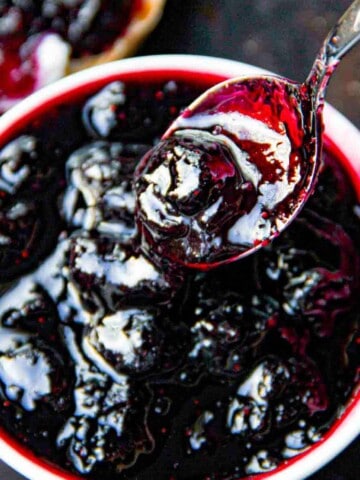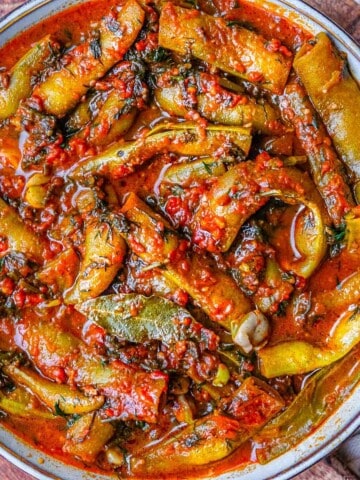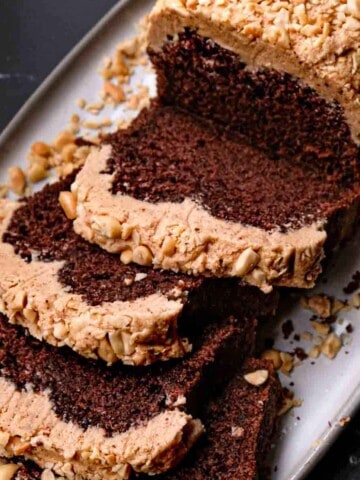Papanasi (pronounced papanash) are Romanian fried donuts made with a fluffy and fragrant sweet cheese dough and served with soured cream (smântâna) and blueberry preserves (dulceață de afine).

Papanasi are a favorite indulgence of many Romanians. When my husband and I visit Romania we always seek out the best papanasi not only because we love how they taste but also because they are linked to so many fond memories and nostalgia for us.
I finally decided to make papanasi at home and I have to say I'm surprised how easy they are to make. I had in mind they'd be really difficult and involve making a brioche dough like cozonac, but actually they're very easy and ready in about an hour.
Putting together this recipe post I also learned something new about what I thought was a quintessentially Romanian dessert.
When I did a bit of research I learned that like so many of the best recipes, papanasi have hopped borders.
Origins of Papanasi and Culinary Connections to Other Countries
Papanasi are really similar to syrniki, which are thick, fried cheese pancakes that are eaten throughout Ukraine (Romania's direct neighbour to the north) as well as Russia and Belarus. There are also Lithuanian varškėčiai Latvian biezpiena plācenīši.
Fun fact: Plācenīši (which Google says means 'scone' but I'm doubtful) is similar to the Romanian word for pie, placinta, both of which are probably derived from the Byzantine layered cheese and honey pie known as placenta.
Byzantine placenta in turn gave us Roman placenta cake, baklava, and probably sweet cheese strudel.
There seem to be two different versions of syrniki from what I can tell.
There are syrniki that look like what we call nalangate in Romania. They often contain raisins and hit that sweet cheese raisin combo we love in Eastern Europe.
I have fond memories of my grandmother making nalangate for me when I was a child and enjoying them with homemade preserves of rose petals, quince and plum.
As I understand it, these are mostly found in the east of the country (Dobrogea) which is where my roots are.
The other type of syrniki are the thick cheese pancakes that are served with fruit preserves called varenye and smetana.
These syrniki are the direct inspiration for papanasi.
Ingredients
I didn't realize until making them myself that papanasi are mostly made of cheese. When you bite into them they feel very soft and doughy - you wouldn't guess they're mostly cheese.
Papanasi are very simple to make and don't have too many ingredients. The only difficulty with making papanasi is that the ingredients you use (for both the donuts and the toppings) are really important.
This section provides information on the best ingredients to use to make papanasi.
Dough Ingredients
Dry cow's milk cheese (brânză de vaci or twarog cheese)
In Romania brânză de vaci (cow's milk cheese) is the traditional choice for papanasi. If you're able to find brânză de vaci then that's the best option.
If you aren't able to find brânză de vaci then there are a few options that I've seen proposed in various recipes.
Alternatively, twarog / tvorog / tvarog cheese: My recommendation is to use twarog / tvorog / tvarog cheese which is a Polish / Russian / broadly Eastern European cheese made from cow's milk. Twarog is a traditional choice in many Eastern European countries for making sweet cheese desserts like strudels and the like. In fact, papanasi a.k.a. syrniki are known as tvorozhniki, tvoroz refering to the twarog cheese that is an essential ingredient in them.
If you can't procure twarog cheese then I've heard that either cottage cheese, ricotta cheese or quark could be good options (used in the same ratio as this recipe) but I haven't tested these myself.
Flour: Regular wheat flour is okay.
Eggs: The eggs bind the other ingredients and add moisture.
Sugar: There's a little bit of sugar in the dough which helps to enhance the other flavors and give the dough a really pleasant taste.
Baking powder: A leavening agent is needed to make the dough light and fluffy.
Salt: A bit of salt will balance everything else out.
Flavoring: Vanilla and lemon zest are the classic flavorings in papanasi dough.

Topping Ingredients
Papanasi are topped with soured cream (known in Romania as smântâna) and blueberry preserves (called dulceață de afine).
smântâna / smetana
Smântâna is known as smetana in English and is used throughout Eastern and Central Europe.
Outside of Romania, I've seen many recipes substitute smântâna with sour cream but this isn't the closest analogue available. Sour cream is only 12 - 20% fat content whereas smetana can be anywhere from 10% to 70%.
Crème fraîche is a higher fat dairy product that more closely resembles smetana in terms of both fat content and taste.
blueberry preserves / dulceață de afine
Dulceață is a key ingredient in papanasi and does a lot of the heavy lifting in terms of flavor. If you have easy access to true Romanian dulceață de afine then you're in luck.
Regular blueberry jam and jelly is not a great substitution for dulceață because the texture is very different.
Jams and jellies are made with pectin which causes them to gel and gives them a totally different texture. Dulceață is just whole fruit cooked in syrup. It's culinary analogues are Russian varenye, spoon sweets, slatko or murabba.
If you are so inclined, making your own dulceață is a fun activity, not complex or time-consuming and the result is so much better than store-bought.
If you want to make your own see my recipe for black currant syrup (dulceață de coacăze negre). This is actually what's shown in the photos here.
If you're a purist and set on the more traditional blueberry syrup, then you can also just follow the same process but use blueberries instead of currants.
Equipment
Non-stick skillet: Papanasi are shallow fried so a non-stick skillet is very helpful to ensure they don't stick.
Wire rack: A wire rack is helpful for putting out the papanasi.
Instant read food thermometer: An instant read food thermometer helps to determine if the oil is at the right temperature so you neither end up with too much oil being absorbed due to the temperature being too low, nor burning due to it being too hot. This is optional but helpful.
Instructions
Start by whisking up the eggs until they are even and well mixed. Then mix in all of the other donut ingredients with a spoon or fork just until the liquids are absorbed and you have a shaggy mixture.

Use your hands to fully mix the dough, ensuring its very homogenous and smooth.
You may find it a bit sticky depending on the type of cheese you use. If it's sticking a lot then rinse your hands and start again with slightly damp hands.

Next divide the dough up into 6 even pieces.
The best way to get really consistent results is to actually weigh the whole thing and weigh out the divided pieces. Your eyes can be deceiving when it comes to eye-balling dough.
For me the whole dough weighs 944 grams / 33 oz. This means when divided by 6 each piece should weigh 156 grams / 5.5 oz. This can depend on what type of cheese you use, the exact weight of your eggs etc.
Divide again, splitting each piece up into a small piece (approximately a quarter of the weight) and a larger piece. Shape the small piece into a ball, and the larger piece into a donut shape.
Set the shaped pieces aside in one layer (for example on parchment paper) while you heat up the oil.

When you are ready to fry, heat the oil in your non-stick skillet until it reaches 105 - 110 C / 220-230 F.
Gently place the papanasi into the hot oil and fry on each side for approximately 3 minutes or until golden.

Once they are golden, remove papanasi from the oil and set on wire rack to drain until ready to top and eat.

Serving Suggestion
Papanasi are best served warm. If they cool significantly after frying, you can microwave them for 30 seconds to a minute to heat back up and then add the toppings.
Top each donut piece with soured cream first and then blueberry preserves. Put the smaller circle piece on top, and top it the same way.

In Romania papanasi are available in a lot of restaurants. They come in pairs of two, already topped with soured cream and blueberry preserves.
When you see them served this way, it invariably gives the impression of...well, two boobs on a plate.

I'm almost certain it's not by accident since one singular 'papanas' is more than enough for one serving.
So to that end I recommend serving them one per person, already assembled and with more soured cream and blueberry preserves on the side.
Recipe

Papanasi: Sweet Cheese Donuts with Blueberry & Cream
Equipment
- non-stick skillet
- wire rack optional
- instant read food thermometer optional
Ingredients
donut
- 500 grams Twarog cheese or see substitutions
- 300 grams flour
- 2 eggs
- 1.5 teaspoons baking powder
- 3 tablespoons sugar
- 1 teaspoon vanilla extract
- 0.25 teaspoon salt
- zest of one lemon
topping
- 1.5 cups crème fraîche or see substitutions
- 1.5 cups blueberry syrup or see substitutions
extras
- 2 cups sunflower oil or other neutral oil for frying
Instructions
- In a large bowl whisk up the eggs until mixed then mix in all of the other donut ingredients with a spoon or fork just until the liquids are absorbed and you have a shaggy mixture.
- Use your hands to fully mix the dough, ensuring its very homogenous and smooth. If it's sticking then rinse your hands and start again with slightly damp hands.
- Divide up the dough into 6 even pieces. See recipe post for details on doing this precisely.
- Divide again, splitting each piece up into a small piece (approximately a quarter of the weight) and a larger piece. Shape the small piece into a ball, and the larger piece into a donut shape.
- Set the shaped pieces aside in one layer (for example on parchment paper) until ready to use.
- Heat the oil in your non-stick skillet until it reaches 105 - 110 C / 220-230 F.
- Gently place the papanasi into the hot oil and fry on each side for approximately 3 minutes or until golden.
- Remove papanasi from oil and set on wire rack to drain until ready to eat.
- Top each donut piece with soured cream first and then blueberry preserves. Put the smaller circle piece on top, and top it the same way.
Nutrition
Related
Looking for more Romanian recipes? Maybe you'll like one of these:









Comments
No Comments